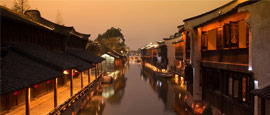Hangzhou History
As the most southerly point of the Grand Canal, the home of poetic West Lake and the recipient of the world's largest tidal bore, water runs through Hangzhou’s history.
The Grand Canal, which ran from Hangzhou to Beijing, was completed in 609 and put the city on the map.
The poet Bai Juyi (772-846 CE) was one of the first artists to mention West Lake when it was still part of the Qiantang River. As a governor of Hangzhou, he also built a dam for irrigating nearby farmland.
It wasn’t until sediment from the Wu and Baoshi Mountains cut the Qintang River off that it became a lake. During the Tang Dynasty (618-907 CE), West Lake would dry up during droughts, so the city’s governor built an underwater system to divert water into the lake.
Hangzhou became the Wuyue state capital during the Five Dynasties and Ten Kingdoms era (907-960) and by the time Marco Polo arrived in the city in the late 13th century, he believed that it was “without a doubt the finest and most splendid city in the world”.
Money came in as rice and silk went out of the port in Hangzhou Bay until the inlet built up with sediment and the harbour became unusable.
In 1860, the Taiping Rebellion ravaged the city. Hangzhou was a mere blot on the 17 provinces the revolt ended up controlling, killing some 20 million people in the process.
Today, cotton, tea and silk are the main industries, while boat trips on West Lake or the Qiantang River tidal bore bring the tourists.
Did you know?
• When Polo passed through in the 13th century, the city had an estimated population of nearly 1.5 million people.
• President Nixon visited West Lake during his 1972 China trip, thawing the icy relations between the USA and China.
• West Lake was inscribed on UNESCO’s World Heritage list in 2011.
Do you have any Feedback about this page?
© 2025 Columbus Travel Media Ltd. All rights reserved. No part of this site may be reproduced without our written permission, click here for information on Columbus Content Solutions.




 You know where
You know where